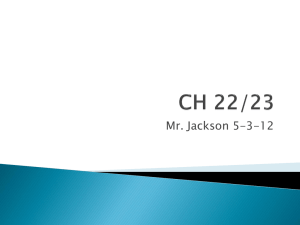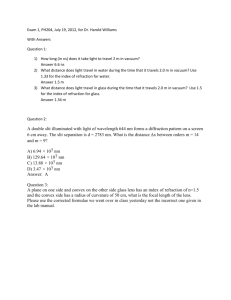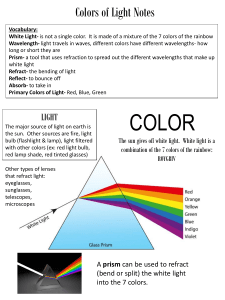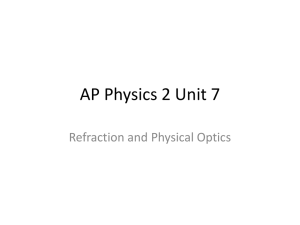LIGHT GLOSSARY
advertisement
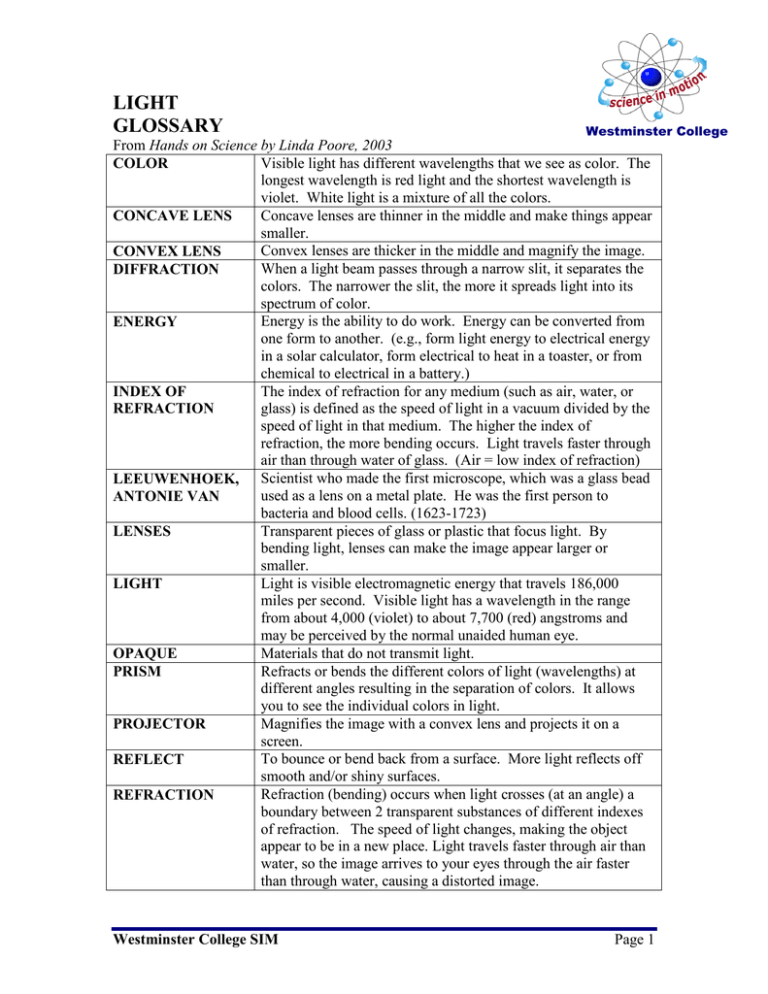
LIGHT GLOSSARY Westminster College From Hands on Science by Linda Poore, 2003 Visible light has different wavelengths that we see as color. The COLOR longest wavelength is red light and the shortest wavelength is violet. White light is a mixture of all the colors. Concave lenses are thinner in the middle and make things appear CONCAVE LENS smaller. Convex lenses are thicker in the middle and magnify the image. CONVEX LENS When a light beam passes through a narrow slit, it separates the DIFFRACTION colors. The narrower the slit, the more it spreads light into its spectrum of color. Energy is the ability to do work. Energy can be converted from ENERGY one form to another. (e.g., form light energy to electrical energy in a solar calculator, form electrical to heat in a toaster, or from chemical to electrical in a battery.) The index of refraction for any medium (such as air, water, or INDEX OF glass) is defined as the speed of light in a vacuum divided by the REFRACTION speed of light in that medium. The higher the index of refraction, the more bending occurs. Light travels faster through air than through water of glass. (Air = low index of refraction) LEEUWENHOEK, Scientist who made the first microscope, which was a glass bead used as a lens on a metal plate. He was the first person to ANTONIE VAN bacteria and blood cells. (1623-1723) Transparent pieces of glass or plastic that focus light. By LENSES bending light, lenses can make the image appear larger or smaller. Light is visible electromagnetic energy that travels 186,000 LIGHT miles per second. Visible light has a wavelength in the range from about 4,000 (violet) to about 7,700 (red) angstroms and may be perceived by the normal unaided human eye. Materials that do not transmit light. OPAQUE Refracts or bends the different colors of light (wavelengths) at PRISM different angles resulting in the separation of colors. It allows you to see the individual colors in light. Magnifies the image with a convex lens and projects it on a PROJECTOR screen. To bounce or bend back from a surface. More light reflects off REFLECT smooth and/or shiny surfaces. Refraction (bending) occurs when light crosses (at an angle) a REFRACTION boundary between 2 transparent substances of different indexes of refraction. The speed of light changes, making the object appear to be in a new place. Light travels faster through air than water, so the image arrives to your eyes through the air faster than through water, causing a distorted image. Westminster College SIM Page 1 PRISMS-OBSERVING COLOR SPECTRUM TELESCOPE TRANSLUCENT TRANSPARENT A mixture of colors produces white light. The order of colors in the spectrum of white light is from red to violet or R.O.Y.G.B.I.V.: red, orange, yellow, green, blue, indigo, violet A device that uses mirrors and/or lenses to gather visible light, permitting direct observation or photographic recording of distant objects. Transmits light but the light is scattered inside the material so you cannot see through it. Material that lets most of the light travel through it. Westminster College SIM Page 2

